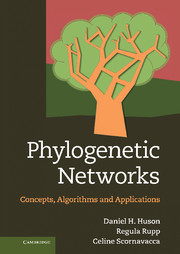1 - Basics
from Part I - Introduction
Published online by Cambridge University Press: 05 August 2011
Summary
In this chapter we introduce some basic concepts and results from mathematics and biological taxonomy.
Overview
The focus of this chapter is on the introduction of graphs (see Figure 1.1). Graphs come in two flavors, undirected and directed. One type of undirected graph that plays an important role in this book is unrooted trees. In the context of directed graphs, we discuss the concept of a directed, acyclic graph (DAG) and then introduce rooted trees as an important example. We introduce a number of different kinds of traversals of trees or DAGs that are often used in algorithms. This chapter concludes by introducing the concepts of taxa, clusters, clades and splits.
Undirected and directed graphs
A graph is a convenient and popular way of representing relationships between objects: in a graph, objects are represented by nodes and relationships between objects are represented by edges. There are two types of graphs, undirected and directed, and we make use of both types throughout the book. First, we define undirected graphs:
Definition 1.2.1 (Undirected graph) An undirected graph G = (V, E) consists of a finite set of nodes V and a finite set of edges E, where each edge e ∈ E is of the form {v, w}, with v, w ∈ V (see Figure 1.2a).
For an edge e = {v, w} we call v and w the endpoints of e and we say that e connects v and w.
- Type
- Chapter
- Information
- Phylogenetic NetworksConcepts, Algorithms and Applications, pp. 3 - 12Publisher: Cambridge University PressPrint publication year: 2010



